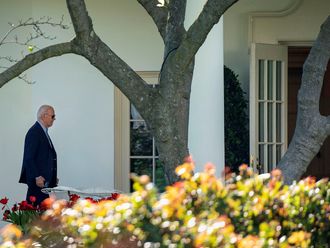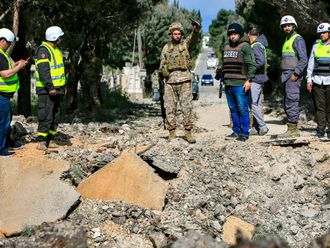HOMESTEAD, United States: When reporters toured a shelter for immigrant children in February, authorities showed off classrooms, soccer fields and art studios to prove the kids were being treated well.
This week President Donald Trump’s administration cancelled all that special care, citing a lack of funding.
Some 13,200 children and teens, most of them Central American, are being held in 168 shelters for minors in 23 states across the United States.
In all of them, activities that are not essential or not linked to the children’s physical safety began to be cut this week.
“We don’t want to make these reductions but the law requires us to do so until Congress appropriates additional funds,” Mark Weber, spokesman for the Department of Health and Human Service (HHS), told AFP.
To address the crisis in handling undocumented migrants, HHS needs $2.88 billion (Dh10.6 billion).
Minors who cross the southern US border without an adult are classified as Unaccompanied Alien Children and sent to centres of the Office of Refugee Resettlement, where they live until they can be reunited with their parents or US-based relatives.
Concentration camps?
Many human rights groups deem these places as being akin to prisons or even concentration camps.
A handful of activists demonstrated Friday outside a shelter in Homestead, a town 70 kilometres south of Miami.
They tried to greet the children through the fence at the facility, and waved red heart signs to show the youngsters were not alone.
A group of boys returned the gesture with smiles — and then made heart shapes with their fingers.
In that facility there are 2,300 children aged 13 to 17, a spokesperson for HHS told AFP.
If they turn 18 while in custody, they are handed over to Immigration and Customs Enforcement.
“Behind me are a few of the kids that are incarcerated in the largest child detention facility in the nation,” said Debby Wehking, a 68-year-old retired school principal. “As a person who was born in Homestead, I’m embarrassed, I’m angry, I’m disappointed.
“I don’t understand why everybody in my country is not on the street, 24/7, complaining until this atrocity comes to an end,” she said.
A visit to Homestead
To show that it was far from a prison or a concentration camp, Weber invited journalists to visit the facility back in February.
It is a set of white tents that have heating and air conditioning, and a few buildings.
The fences that surround the facility are covered by a green tarp that makes it difficult to see through.
Inside, children walked in orderly lines, back and forth to different activities.
Journalists were asked not to talk to them beyond saying “hello” and “good morning.”
And so it was: a line of girls passed by the journalists and cheerfully greeted everyone saying “Good morning!” in Spanish.
The dormitories — separate for boys and girls — were in one of the buildings.
The 17-year-olds, however, slept apart, in a large space with about 150 berths in rows, lined up with just enough space between them for a person to get through.
In one of the tents, a large one with metal tables and chairs, were the classrooms where fifty teachers gave English and mathematics classes. This programme will be eliminated.
All the facilities were decorated with drawings made by children in their art workshops, to give something of a cosy atmosphere to a tough situation.
This programme will also be eliminated.
In one tent that functioned as a movie theatre, where there was a TV and an Xbox, there was a drawing of a beach with a small boat, palm trees and swings.
Below it was a pamphlet with warnings about sexual abuse and teen pregnancy.
Just like the art programme and the soccer programme, it will all be on the chopping block unless Congress grants the Department of Health and Human Services the funds it needs.
“We have a humanitarian crisis at the border brought on by a broken immigration system that is putting tremendous strain on the Office of Refugee Resettlement and its Unaccompanied Alien Children program,” said Evelyn Stauffer, a spokeswoman for the children and families section of HHS.












